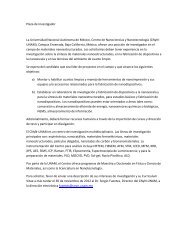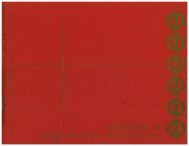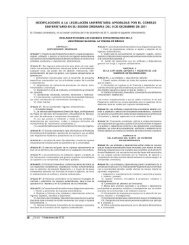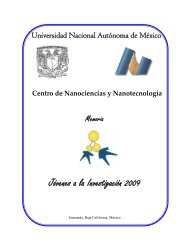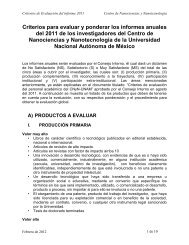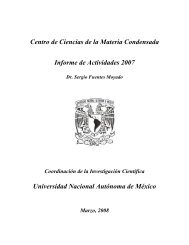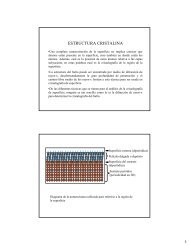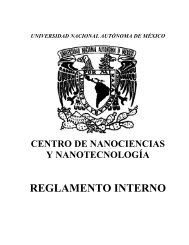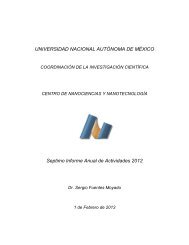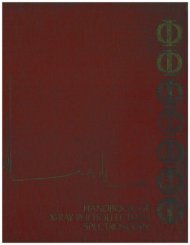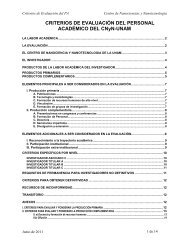Universidad Nacional Autónoma de México - CNyN
Universidad Nacional Autónoma de México - CNyN
Universidad Nacional Autónoma de México - CNyN
Create successful ePaper yourself
Turn your PDF publications into a flip-book with our unique Google optimized e-Paper software.
1st International Symposium on Nanoscience and Nanomaterials<br />
a vcorral@ciqa.mx, b cevalmart_18@hotmail.com, c mgarciagua<strong>de</strong>rrama@dip.udg.mx,<br />
d enrique.torres@cimav.edu.mx<br />
Keywords: Chemical Growth, Nanomaterials, Zinc Oxi<strong>de</strong>.<br />
Zinc oxi<strong>de</strong> rods were synthesized by aqueous chemical growth on different substrates, e.g. plane<br />
glass, ITO-coated glass substrates, stainless steel and platinum-coated silicon wafers. The effect of pressure<br />
was studied on open and closed reaction vessels at 90ºC for six hours on ITO-coated glass substrates. Closed<br />
reaction gave rise to conic shaped rods with average diameter of 0.61 ± 0.21 µm, while more homogeneous<br />
rods of 0.91 ± 0.17 µm were grown at open conditions. Rod length increased from 3.00 ± 0.47 to 3.67 ± 0.92<br />
for close and open conditions respectively. As for the effect of reaction time, a sample was grown for 20<br />
hours at closed conditions. Ave. diameter was not affected significantly, while length increased up to 7.30 ±<br />
0.85 µm. Pt-coated silicon and stainless steel substrates promoted the formation of ZnO rods with a flowerlike<br />
morphology, with similar dimensions than those grown over glass. In all cases, the hexagonal phase was<br />
verified by grazing inci<strong>de</strong>nce X- ray diffraction.<br />
O-021<br />
Au/Ce-Al-O CATALYSTS FOR AEROBIC OXIDATIVE ESTERIFICATION OF BENZYL<br />
ALCOHOL<br />
E. Smolentseva 1,a , A. Simakov 1,b , R. Cotta 2,c , V. Costa 2,d , E. Gusevskaya 2,e , S. Fuentes 1,f<br />
1 <strong>Universidad</strong> <strong>Nacional</strong> Autónoma <strong>de</strong> México, Centro <strong>de</strong> Nanociencia y Nanotecnología, km.107, carr. Tijuana<br />
- Ensenada, C.P. 22860, Ensenada, B.C., México.<br />
2 <strong>Universidad</strong>e Fe<strong>de</strong>ral <strong>de</strong> Minas Gerais, 31270-901 Belo Horizonte, MG, Brazil.<br />
a elena@cnyn.unam.mx, b andrey@cnyn.unam.mx, c, d, e elena@ufmg.br, f fuentes@cnyn.unam.mx<br />
Keywords: Ce-Al mixed oxi<strong>de</strong>s, gold nanoparticles, benzyl alcohol, aerobic oxidation.<br />
Gold nanoparticles (NPs) are consi<strong>de</strong>red as the promising catalysts for the aerobic oxidation of<br />
alcohols, which involve O 2 as an oxidant, due to their high activity and stability. Gold catalysts (3 wt.% Au)<br />
supported on single and mixed nanostructured oxi<strong>de</strong>s (Al 2 O 3 , CeO 2 and Ce-Al-O) were prepared by<br />
<strong>de</strong>position-precipitation with urea and studied in aerobic oxidative esterification of benzyl alcohol in the<br />
presence of methanol. Fresh and spent samples were characterized by FTIR, in situ UV-Visible spectroscopy<br />
and TEM. It was found that the gold catalysts supported on ceria and Ce-Al-O mixed oxi<strong>de</strong>s are quite<br />
effective for the liquid-phase oxidation of benzyl alcohol with formation of two products: al<strong>de</strong>hy<strong>de</strong> and ester,<br />
even in the absence of base promoter. The selectivity of catalysts <strong>de</strong>pends on the nature of the support used,<br />
the type of catalysts pretreatment (reductive or oxidative), temperature and the reaction time. The authors<br />
thank to E. Flores, P. Casillas, V. García, F. Ruiz, E. Aparicio, M. Vega, J. Palomares, M. Sainz and J. Peralta<br />
for their kind technical support in this work. This project was supported by DGAPA–PAPIIT (UNAM,<br />
Mexico) through grant 224510.<br />
22




